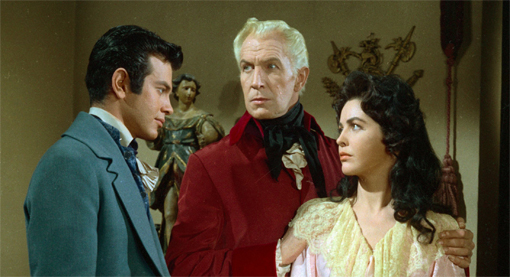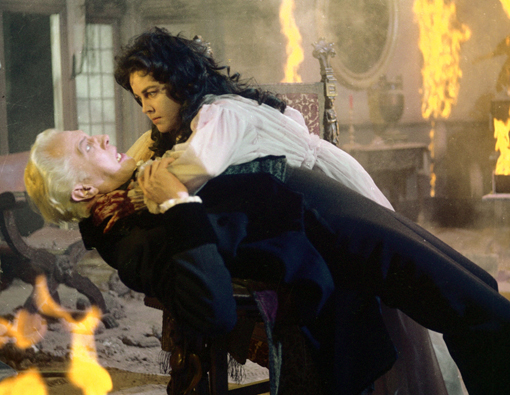The Fall of the House of Usher
The Fall of the House of Usher. GB. 2013. Blu-ray. 85 minutes + 90 minutes extras. £13.99
About the reviewer: Andrew Ormsby is the BUFVC Information Officer and is also Content Co-ordinator on the EUscreenXL project.
E-mail: andrew@bufvc.ac.uk
Tel: 0207 393 1507
‘It is not everyone who can put ‘a good thing’ properly together,’ wrote Edgar Allan Poe in an essay ‘On Unity of Effect’ in the Southern Literary Messenger in June 1836. Roger Corman’s 1960 film The Fall of the House of Usher (or ‘House of Usher’, as it was released in the USA) was the first in the director’s series of Poe adaptations for American International Pictures, and critical opinion tends to rank the later films, such as Masque of the Red Death, more highly. Nonetheless Usher, presented here in its original aspect ratio in Arrow’s beautifully restored Blu-Ray version, shows that Corman knew what he was doing from the beginning. The film’s flaws, such as they are, ensured that the film was given a mixed reception on release but since then its reputation has grown in stature (the benefit of hindsight comes into play here of course, since we can now see the film as part one of a series and forgive its more obvious missteps) and this edition, extremely well presented and accompanied by an interesting and informative selection of extras can only further enhance Corman’s reputation even if, in the final analysis, the film as a whole falls short of being an out and out masterpiece.

To deal with the weaknesses first. Most obviously, as Jonathan Rigby points out in the interview featured on this disc, the supporting cast – Mark Damon and Myrna Fahey as the juvenile leads, and Harry Ellerbe as the faithful old retainer Bristol – struggle to match the performance of Vincent Price as Roderick Usher. Damon, in particular, fails to bring much of interest to the character of Philip Winthrop, although – as Rigby rightly points out – his task is a pretty thankless one. In the original story the unreliable narrator is already ‘unnerved’ and ‘given to shadowy fancies’ before he even arrives at the house, whereas in the film Winthrop is, one suspects, not given over to introspection and is resolutely unimaginative, if admirably single-minded, in his desire to whisk his betrothed Madeline Usher away to Boston where the pair can be married. Madeline herself, who, in Poe’s tale is barely seen before her cataclysmic appearance at the end of the story, is written in the movie as Winthrop’s love interest, and the romantic scenes here present the film’s only real longueurs, although credit must be given to Fahey’s climactic return from the tomb at the film’s terrifying climax.
… Poe understood, and indeed was obsessed by, the psychology of terror
So much for the film’s obvious weaknesses. However, Corman, himself a devotee of Poe since a teenager, understood the deeper underlying reasons for the power and appeal of the writer. Beyond the immediately obvious cinematic qualities of Poe’s imagery, the stories operate on a deeper level and much of their power derives from the way they work in the unconscious mind. Poe understood, and indeed was obsessed by, the psychology of terror, so that his stories often function as commentaries on their own effects, even as the narrative ratchets up the tension through its depiction of bizarre events. As the narrator in ‘Usher’ [ie. the story] puts it: ‘the consciousness of the rapid increase of my superstition… served mainly to accelerate the increase itself.’ Poe’s modernity in this sense, his metatextual awareness of terror’s self-reflexivity and the interiority of his tales, which are depictions of mental states as much as stories about strange happenings, is all well-understood by Corman and shows itself in the film’s most compelling aspects. Corman himself summed it up more concisely when questioned by AIP chief Sam Arkoff, who expressed concern that the story lacked a monster. Corman’s reply, ‘The house is the monster,’ might have been off the cuff but it’s an accurate reflection of Poe’s story and again shows how in tune Corman was with the source material.
Another big strength is Floyd Crosby’s Eastmancolor CinemaScope cinematography. The opening sequence, in which Winthrop rides towards the house through an eerie landscape of smoking burnt-out trees – the story’s ‘singularly dreary tract of country’ – puts us immediately inside the narratives dreamlike world and Daniel Haller’s production design adds to the sense of uncanniness. A perceptive essay by Tim Lucas in the booklet accompanying the disc notes the importance of colour and width and also points out that Crosby’s use of a 24mm lens gives the film its sense of depth: especially evident in the film’s opening sequence, where the deep focus shot of Winthrop riding through the forest is framed by the closer, finger-like branches of the trees, which, as Lucas says, reach out as if pulling us into the film.
It might be argued that the use of deep focus is one of the keys to understanding the film: certainly it demonstrates Corman’s affinity with his source materials, given that that Poe uses language to evoke similar effects. A particularly startling example in the story is when the narrator sees the Lady Madeline passing slowly ‘through a remote portion of the apartment,’ where the effect of the word ‘remote’ is the literary equivalent of a deep focus shot, pulling the reader in, and making him/her look deeper and see further. Here Poe forces us to imagine an act of seeing that is rendered dreamlike but bizarrely precise at the same time. The language of the story works on the visual senses via the imagination and sharpens the reader’s awareness so that perception becomes, like Roderick Usher’s, a paradoxical mixture of acutely sensitivity and extreme unreliability: the site of uncertainty and potential madness.

In addition to Crosby’s cinematography and Corman’s direction, mention must be made of Vincent Price in the role of Roderick Usher. Playing the role with a restraint dictated by the character’s seethingly repressed hypersensitivity, Price powerfully conveys a man struggling to control his incipient madness: a slow-burning performance that only serves to highlight the inadequacies of the supporting actors.
Along with Rigby’s excellent interview and the booklet, extras include an audio commentary track by Corman, a video piece by Joe Dante on Corman’s Poe Cycle and an interview with Price from 1986 made for French television. A ten-minute video essay by David Cairns is somewhat mannered in its presentation and not long enough to really develop the ideas thrown out by Cairns but contains enough material to kick-start a discussion of the film.
Andrew Ormsby
 Learning on Screen
Learning on Screen